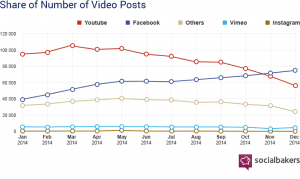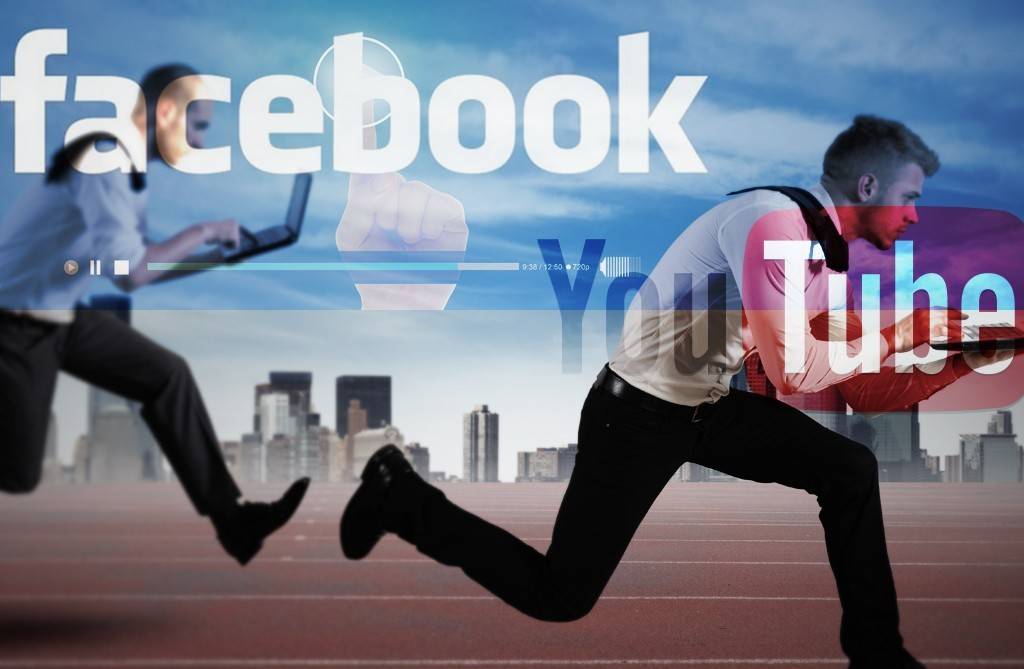It’s official Facebook Video is now Bigger Than YouTube for Brands!
Okay so the title is a bit sensationalist, but recent statistics from Socialbakers (a global Social Media Statistics and Insights Company) show that with the recent changes to the way Facebook handles video, brands are now uploading more videos to Facebook directly instead of sharing YouTube videos.
So what does this all mean? As Facebook has consistently outperformed YouTube in terms of driving views and engagement, content marketers have reacted and are switching from sharing videos from YouTube to natively published Facebook videos. A year ago, YouTube was THE network for video in terms of sheer video quantity, nearly doubling the number of videos published on any other content network. However with Facebook’s continually updated algorithms, natively uploaded videos are given preference on Facebook over YouTube shared video. This has seen a staggering 50% increase from January through May of marketers uploading videos directly to Facebook and bypassing YouTube completely.
A year ago, YouTube was THE network for video in terms of sheer video quantity, nearly doubling the number of videos published on any other content network. However with Facebook’s continually updated algorithms, natively uploaded videos are given preference on Facebook over YouTube shared video. This has seen a staggering 50% increase from January through May of marketers uploading videos directly to Facebook and bypassing YouTube completely.
Of course each Social Media platform is a digital marketing business in their own right. With the constant updates in technology need to stop being middlemen who simply host and distribute referral links to other Social media platforms. Driving traffic to outside domains and other Social Media platforms takes their customer (you) away from THEIR platform whereas hosting video content natively on their own platform keeps you (their customer) engaged and on their platform longer. Given the quality of engagement video generates, it’s easy to see why.
For this reason, Facebook has been quickly and fairly quietly building their new video options over the past year, adding auto-play, view counts, and better mobile functions to their native video player. The network has already been quite successful in the initial stages of their so-called “shift to video,” citing mind-blowing numbers like an average of 1 billion views per day on video content since June 2014.
Some of their early success can be attributed to one-off phenomena like the Ice Bucket Challenge, much of which was shared organically through Facebook’s easy-to-use video creator. But Facebook’s implementation of auto-play on its native videos cannot be overlooked. Anyone who has used Facebook in the last few months has probably seen their feed filled with auto-play videos, which automatically begin to play (minus the sound) as you scroll down.
 For brands and business, digital video, particularly on mobile, is becoming more important as well. Facebook has even stated that 65% of Facebook videos viewed are on mobile. Combining sight, sound and motion, video creates experiences that are, at their best, memorable, moving and inspiring — the types of experiences that can help small business increase important metrics such as awareness, consideration and, ultimately, sales.
For brands and business, digital video, particularly on mobile, is becoming more important as well. Facebook has even stated that 65% of Facebook videos viewed are on mobile. Combining sight, sound and motion, video creates experiences that are, at their best, memorable, moving and inspiring — the types of experiences that can help small business increase important metrics such as awareness, consideration and, ultimately, sales.
Facebook is also deliberately pushing YouTube off their platform. Test it for yourself, try to include a YouTube link in a Sponsored Post… Facebook won’t let you. This alone has successfully halted the paid distribution plan for any video campaign that’s hosted on YouTube.
So does this mean Facebook Video has finished off YouTube? My experience and testing say no. Social Media needs to be INTEGRATED. If you upload the video natively to Facebook, you get the improved engagement from Facebook users. Uploading your video to your YouTube channel puts it not only in front of your subscribers, but gets the video indexed in YouTube search and has much longer potential reach. This also means your video can be embedded on your website, shared across Google+, LinkedIn, Twitter and even Instagram.
Not sure which step to take now? Let’s talk and see how we can include video into both Facebook and YouTube creating an integrated marketing experience for your customers.






















